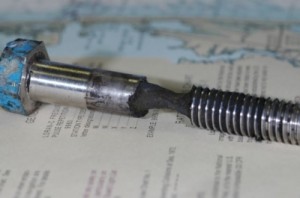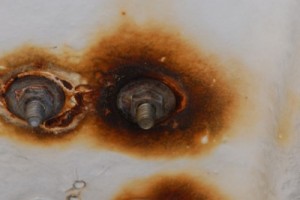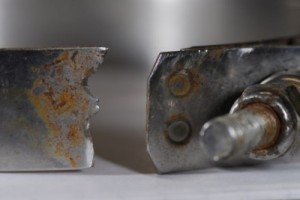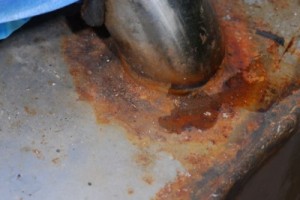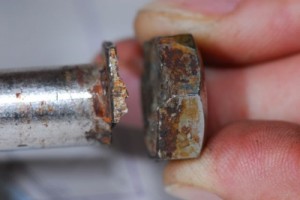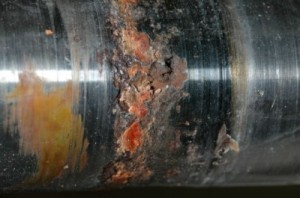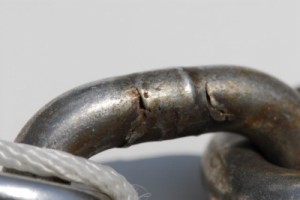Stainless Steel – Miracle Metal?
This “wasp-waisted” strut bolt represents a classic example of crevice corrosion
Stainless steel; the very name implies virtual metallurgical immortality. Since its accidental discovery nearly 100 years ago, stainless steel has become a fixture in everything from automobile and household appliance manufacturing to skyscraper trim and turbine blades. Of course, it’s also well known to recreational boat builders, boat yards and owners. The average cruising vessel is simply riddled with a variety of stainless steel alloys, of which there are several, that are called upon to support everything from propellers (stainless alloy propeller shafts) to headliners (stainless steel staples).
Some grades of stainless steel are more corrosion resistant than others. These fasteners are likely 304 series and as such are staining, a clear indication that crevice corrosion is occuring
It comes as a surprise to many casual and professional users alike then that the primary alloy contained within stainless steel is humble and familiar iron. There’s a reason, after all, that it’s called stainless steel. To this mundane and plentiful element other more exotic alloys such as chromium and nickel are added, giving stainless steel its corrosion resistant properties. The chrome enables stainless steel to form a tough oxide film as soon as, and for as long as, it’s exposed to oxygen. This film exists even while submerged provided the water contains oxygen. The addition of nickel increases its resistance to acid. Depending upon the role it will be called upon to fill, architectural trim, cutlery or bow rail for instance, differing amounts of elements are added, along with trace amounts of still more exotic materials such as columbium and tantalum.
StainlessT-Bolt hose clamps are usually very strong, however, the folded design traps water, creating an ideal environment for crevice corrosion.
Essentially, there are three sub-groups of stainless steel; martensitic, which is often used for cutlery, many fasteners and turbine blades; ferritic, which is used for automotive trim applications and austenitic, which is used in the marine environment. Of the three, high nickel content (6% or more) is exclusive to the austenitic or marine grade. Thus, contrary to its silvery appearance, not all stainless steels are created equal. Marine grade stainless steel is further distilled into two popular alloys, designated by the American Iron and Steel Institute as 300 series. For recreational marine applications, the most common of these are 304 and 316. The alloy ratio used in 304 stainless steel consists of 18%-20% chromium and 8%-12% nickel, which is added to conventional carbon steel. For this reason, 304 stainless steel is often referred to as 18-8. The alloy ratios for 316 stainless steel, on the other hand, are 16%-18% chromium (greater than 304) and 8%-12% nickel, as well as 2%-3% molybdenum. The final ingredient aids 316’s ability to resist a phenomenon referred to as crevice or pitting corrosion.
By far, the most common variety of, “marine grade” stainless steel is 304 or 18-8. As one might expect, this is a function of expense. Because of the alloying element content, 304 is less expensive to manufacture than 316. Nearly all commonly available stainless fasteners, from the smallest tapping screw to large nuts and bolts, are manufactured from 304 alloys. Fasteners, machine screws, nuts and bolts manufactured from 316 alloy stainless steel are available; however, they must nearly always be special ordered, which, once again, is a reflection of their expense.
The use of the incorrect stainless alloy, it wasn’t “L” or low carbon, precipitated an early end for this tank.
There wasn’t much strength left in this corroded bolt head. Corrosion gains a foot hold in micro-cracks or crevices that form in highly stressed components
Stainless steel’s other primary weakness, the aforementioned crevice or pitting corrosion (there is a scientific distinction between the two, however, for the purposes of this discussion it’s not relevant), occurs when it is used in an oxygen depleted environment. The tough, nearly impenetrable oxide film that forms as soon as stainless steel is exposed to air (the term inox, seen on many European stainless components is simply an abbreviation for inoxodizable, which refers to stainless steel’s resistance to oxidization or staining) only remains intact as long as the metal is exposed to oxygen. If stainless steel is placed in an environment where it is starved of oxygen and it is exposed to water, either fresh or salt, it becomes susceptible to crevice corrosion, which typically manifests itself as roughness, valleys, pitting or even worm-like holes.
Therefore, it is preferable to avoid using stainless steel in applications where it is regularly exposed to stagnant or still water for extended periods. Ideally, high quality silicon bronze, cupronickel, inconel or non-metallic alternatives should be used, particularly for fasteners and raw water plumbing. The fasteners used to secure struts, strainers and other underwater hardware, for instance, should be bronze rather than stainless steel. If stainless steel must be used in such an application, for a custom made strut or shaft log for instance, it should be fabricated from the most corrosion resistant marine alloy available, 316L or 317L.
Less corrosion resistant stainless shaft alloys often suffer from crevice corrosion, especially in the oxygen deprived stuffing box region, shaft log and under cutless bearings, all areas that aren’t readily visible.
Propeller shafts fall into a special category. Because they require both exceptional strength and corrosion resistance, propeller shafts are typically fabricated from a proprietary stainless alloy that includes a host of other trace elements. These mixtures yield the ideal combination for the environment in which shafts operate. Trade names such as Aquamet, Aquatech and Aqualoy among others are available in several strength and corrosion resistance grades. The most corrosion resistant of which, and therefore the most desirable for recreational applications where use and oxygen exposure is limited, is designated as 22. Shafts made of this alloy and grade are as close as a boat builder can get to corrosion-proof where steel-based alloys are concerned. Shafts manufactured from ordinary stainless steel, on the other hand, even 316 alloy, frequently suffer from crevice corrosion attacks, occasionally within less than a year of being placed in service beneath cutless bearings and stuffing box packing, once again, where the damage cannot be easily observed. In order to avoid corrosion and failures, use stainless steel where it works best and specify the right alloy for the job.
One would think that stainless steel anchor chain would be the Cadillac of ground tackle. However, just like many other stainless steel alloys it can fall prey to corrosion under the right circumstances.
For more information on the services provided by Steve D’Antonio Marine Consulting, Inc. please e mail Steve at info@stevedmarineconsulting.com
or call 804-776-0981
